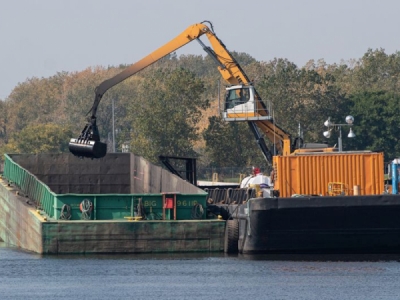
Posted on October 13, 2020
The U.S. Army Corps of Engineers recently resumed dredging at the Indiana Harbor and Shipping Canal in East Chicago.
Ohio-based contractor Kokosing Construction Co. and Illinois-based O’Brien and Gere plan to dredge about 150,000 to 200,000 cubic yards this fall, according to the Army Corps.
“The navigation project consists of a harbor channel ranging in depth from 27 to 29 feet low water datum, and two canals with depths of 22 feet,” according to a release. Since 2012, more than 1.58 million cubic yards of sediment has been removed from the canal, both for more efficient commercial navigation and to stop contaminated sediment from going into Lake Michigan, the release said. Dredging at the Harbor Canal first began in 1972.
“By next year, a majority of the federal channel will be dredged to congressionally-authorized navigation depths, including the removal of sediments in adjacent berthing and docking areas, at a nonfederal expense,” U.S. Army Corps spokeswoman Vanessa Villarreal said in a release.
In 2014, the Army Corps applied for a permit that would allow the disposal of toxic sediment from the canal containing PCBs into its confined disposal facility (CDF) in East Chicago, 3500 Indianapolis Blvd. At that time, the corps was not allowed to dredge the most toxic locations in the canal because it didn’t have the authorization to store the dredged material at the facility in East Chicago.
East Chicago residents, environmental activists and university researchers pushed back against the permit, calling for an alternative disposal site.
The canal and the CDF are located less than 1/2-mile from East Chicago Central High School, adjacent to Tod Park and near an East Chicago fire station.
Thomas Frank, an organizer with the Community Strategy Group, who opposed it, said Friday he hasn’t kept up with dredging this season, partly because of the pandemic.
“During COVID, we’ve been closed off and hidden from the process,” he said, of environment regulation policy changes. “In this case, we had a universal voice that we did not want this permit and to find another solution.”
The U.S. Environmental Protection Agency and Indiana Department of Environmental Management initially delayed approval in 2017 as it examined off-site disposal options. Both agencies eventually approved the permits around December 2018, saying the CDF was “proven, effective and appropriate” for disposing an estimated 4,000 cubic yards of highly toxic sentiment with PCB concentrations above 50 parts per million. After approval, dredging was scheduled to start in 2019.
“EPA determined there was much less PCB-contaminated sediment (approximately 20,000 cubic yards) than (Army Corps) had originally estimated (60,000 cubic yards). A Great Lakes Legacy Act cleanup, however, would require a non-federal project partner to share costs and long-term maintenance responsibilities and EPA was unable to find an appropriate partner that could meet the requirements for the project,” it said.
Source: chicagotribune





